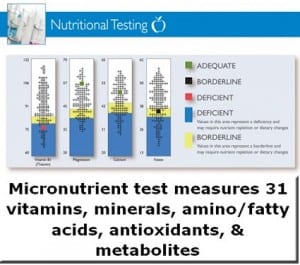Do you take vitamins & supplements on a regular basis? If you do, how do you determine whether or not they are working?
I personally suggest having periodic lab work completed (every 6-12 months) to monitor nutrient serum levels appropriately. But this advice has one caveat: serum levels don’t reveal what is happening at the cellular level.
Why does this matter? It matters because the most optimal healing occurs at the cellular level.
The good news is that SpectraCell’s Micronutrient Testing reveals micronutrient levels within your cells, providing a more complete picture of what is happening inside your body.
Let me explain:
Essentially SpectraCell’s micronutrient testing is different from serum lab results because instead of measuring nutrient levels in the blood, it measures nutrient levels within your cells.
How is this done?
Test Procedure Overview:
- A mixture of lymphocytes are isolated from your blood sample
- These cells are grown in a culture medium containing optimal levels of all essential nutrients necessary to sustain their growth in the cell culture
- T-lymphocytes are stimulated to grow with a mitogen (substance) and growth is measured by the incorporation of tritiated (radioactive) thymidine into the DNA of the cells
- The growth response under optimal conditions is defined as 100%, and all other growth rates are compared to this the 100% level of growth.
What Does The Micronutrient Report Provide?
- Test Result (% Control) – represents the patient’s growth response in the test media compared to the optimal growth observed in the 100% media
- Functional Abnormals – interpretation for those nutrients found to be deficient
- Reference Range – how the patient’s result compares to thousands of previously tested patients
- Graphs – color coded charts showing personalized abnormal results, abnormal ranges and a representation range of randomly selected subject for comparison
- SPECTROX (Total Antioxidant Function) – a measurement of overall antioxidant function based on the cell’s ability to resist oxidative damage
- Individual Antioxidant Levels – determines which specific antioxidants may be deficient and therefore affecting the SPECTROX antioxidant function result.
- Immunidex – an indication of the patient’s T-Lymphoproliferative response to mitogen stimulation relative to the response of a control population. An average or weakened immune response may improve with correction of the nutritional deficiencies determined by the micronutrient testing.
How Do Micronutrient Levels Apply To Various Conditions?
People with the following conditions, may be suffering from the associated deficiencies.
- Fatigue: Chromium, Zinc, Asparagine, Biotin, Glutamin, Serine, CoQ10, Fructose Intolerance, Magnesium, Antioxidants, Vitamin C, Vitamin A, Vitamin E, Vitamin D, B Vitamins and Carnitine
- Headaches: Lipoic Acid, Vitamin C, Vitamin B12, Folate, Glutathione, Magnesium, Vitamin D & Calcium, Vitamin B2, Vitamin B3 and CoQ10
- Other Common Conditions and Related Deficiencies for People With Autoimmune Illnesses:
- Hypothyroidism: B Vitamins, Vitamin C, Vitamin E, Vitamin A, Zinc, Copper, Selenium, Asparagine, Carnitine, Lipoic Acid, Choline and Glutathione
- Difficulty with Weight Loss: Asparagine, Biotin, Carnitine, Calcium, Lipoic Acid, Chromium, Vitamin B5, Magnesium, Glutamine, Cysteine, Inositol, Vitamin B3 (niacin), Vitamin A, Vitamin E, Vitamin D, Vitamin K and Zinc
- Telomeres (aka, aging): Calcium, Folate, B3, B2, B6, B12, Cysteine, Zinc, Copper, Magnesium, Selenium, Glutathione, Vitamin C, Vitamin E, Vitamin D and Manganese
That’s right, stubborn weight loss and premature aging may be a result of nutrient deficiencies that prevent your body from functioning optimally.
What If You Don’t Want To Take A Lot Of Supplements?
I support the philosophy to supplement as minimally as possible. I’m not an advocate of mega doses and I dislike telling people to spend money, especially when I know it’s a hardship.
However, our food supply has changed significantly in the past 50 years:
- Produce is grown in mineral-depleted soil
- Fresh food travels for long periods of time resulting in reduced nutrient levels
- Modern meals contain refined ingredients: stripped of nutrients and enriched with substances that have lost their synergistic benefits
- These factors and more, have contributed to the average person having five or six nutrient deficiencies when completing the SpectraCell Micronutrient Testing.
To find out more about SpectraCell Micronutrient Testing contact our office for a consult!

